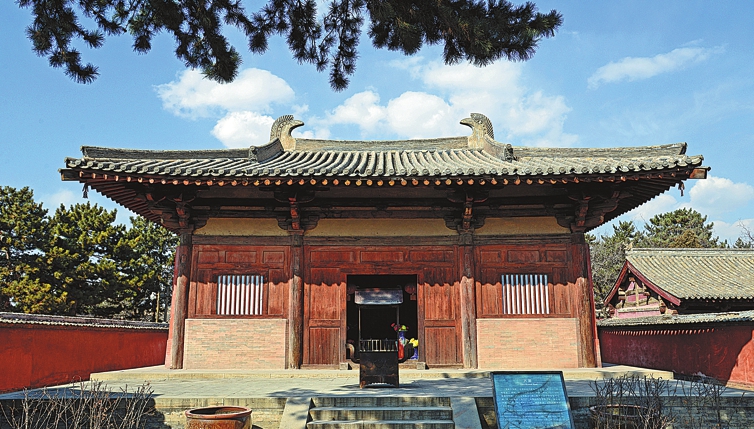The main hall of Nanchan Temple in Wutai county is the earliest wooden structure in Asia. Lu Junhua / For China Daily
Although the religion of Buddhism has been in China for nearly 2,000 years,the chance of finding wooden-structured Buddhist temples from more than 1,200 years ago is almost zero.
The persecution of Buddhism by Tang Dynasty(618-907)Emperor Wuzong during the Huichang era(841-846)caused the disappearance of almost all the Buddhist temples in China.
But at least one Buddhist temple,in the Wutai Mountains of Shanxi province,survived the era,with its main wooden structures standing to this day.
The Wutai Mountains in Wutai county is a renowned Buddhist holy land and a top tourist destination in Shanxi.It is said to be the venue where Bodhisattva Manjusri preached his teachings and is home to a great number of Buddhist temples.
Renowned ancient architecture researchers-Liang Sicheng and Lin Huiyin,who were also a couple-discovered the Foguang Temple in Doucun township,Wutai county,in the 1930s.
Their intensive research,including study of the architectural style,structural details and inscriptions,proved that the Grand Eastern Hall in Foguang is a Tang Dynasty structure built in 857.They believed that was the earliest wooden structure in Wutai and one of the earliest in China.Despite its long history,this is a post-Huichang structure.
When conducting a survey of local ancient structures in the 1950s,researchers in Shanxi discovered a small Buddhist temple called Nanchan in the village of Lijiazhuang,Wutai county.
Inscriptions on a column of the main hall showed that it was among the remains of a temple built in 785,about 60 years before the Huichang era.
At this news,experts from the then Ministry of Culture made a research tour of the temple.It proved that Nanchan is the only pre-Huichang Buddhist temple in China and the earliest wooden structure in the country and in Asia.
Experts said one of the reasons that Nanchan Temple survived the Huichang persecution of Buddhism and other anti-Buddhism campaigns in later dynasties is that it was located in a remote village.It is more than 80 kilometers away from the town of Taihuai,the hub of Buddhist temples in the Wutai Mountains.
One of the unique characteristics of the temple is that its main hall,which features sloped roofs and overhanging eaves,which were identified by researchers as a typical style of the Tang Dynasty.
"The hall with gently sloped roofs and overhanging eaves resembles a flying bird,"said researchers who discovered the site."This was identical with Tang Dynasty poets'frequent descriptions of palace and temple buildings as'flying birds'."
Inside the hall are 17 statues from the Tang Dynasty,which are said to be one of the earliest Buddhist statues in China next only to those in the Mogao Grottoes in Dunhuang,Gansu province.
Standing at the center is Vairochana Buddha,one of the incarnations of Sakyamuni Buddha.He is surrounded by his 16 followers.
Among them are two bodhisattvas with the shape and appearance of females.They have curved eyebrows and plump cheeks,which were typical features of Tang Dynasty beauties,according to the researchers.
Peng Ke’er contributed to this story.
By Yuan Shenggao

